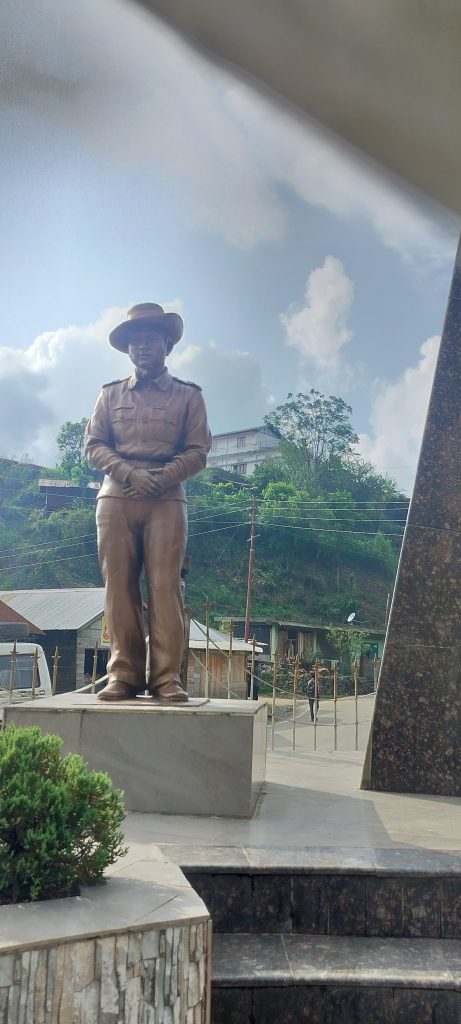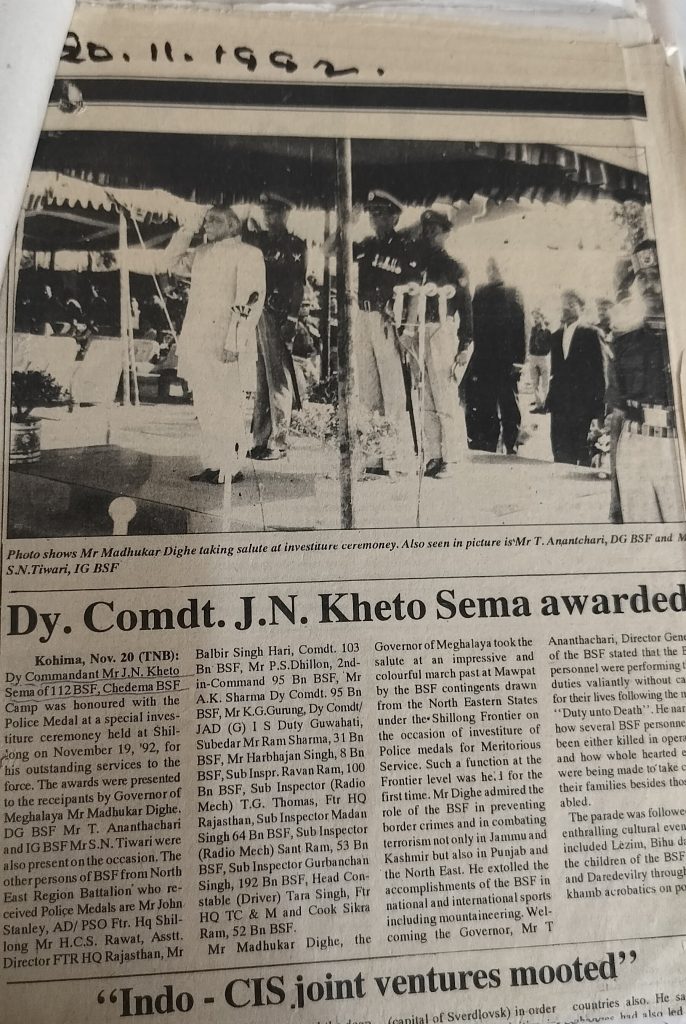The Highland Institute is collaborating with the Department of Sociology and Anthropology at the National University of Singapore on a research project entitled ‘Soldier-Citizens Labouring in the Border Security Force.’ The project focuses on an important period in Naga social history and examines how it was that, from the early 1970s, Naga men came to join the Indian Border Security Force (BSF), a former enemy. In our research, we probe the experiences of these ‘soldier-citizens’ during their years of service and after their retirement. We aim to record the stories and struggles of ordinary people and their families and gain a greater understanding of this complex chapter in Naga history. This article describes a recent field trip to Zunheboto, Nagaland, and shares some of the poignant stories related by retired BSF personnel and their relatives.

Stepping Foot on the Land of Warriors
In June 2024, I set off for Zunheboto District, the so-called ‘Land of Warriors’. The area, situated in the heart of Nagaland, takes its name from a flowering shrub ‘zunhebo’, which grows abundantly in the region, and ‘to’ or ‘ato’ meaning a ‘hilltop’. Zunheboto is bounded by Mokokchung District in the north, Phek District in the south, Tuensang and Kiphire districts in the east, and Kohima and Wokha districts in the west. The whole area, totalling 1255 sq. km, is mountainous and covered with dense forest. As per the 2011 census, the district has a population of 1,14,014. The district headquarters in Zunheboto town is 150 km away from the state capital, Kohima. Zunheboto is the heartland of the Sumi Naga community to which I belong, but this was my first visit to this area and I was excited.
My shared taxi arrived in Satakha Town, home of the heroes of the Great Naga 111 Battalion Border Security Force. I was eager to catch a glimpse of the statues commemorating the legendary Sumi heroes General Kaito Sukhai and Kughato Sukhai and requested my co-passengers to tell me as soon as they became visible. Disappointingly, I only saw the two statues from far off and resolved to pay a proper visit in the following days.


Statues of two Naga Warriors from the Sumi community. Photo Courtesy- Esther Swu
The Great Naga Battalion
In the early 1940s, the Naga desire for self-determination led to the formation of the Naga National Council (NNC), the Naga political body, in 1946. Later, in the early 1950s, the Naga Army was created and the movement abandoned its non-violent approach. The first Indo-Naga battle took place from 4 to 10 September 1955 at Hoshepu village and was followed by the famous Battle of Satakha in the year 1956. News of the Naga victories in both these battles spread like wildfire throughout the Naga-inhabited areas, boosting the morale of the youth. The Naga youth, particularly the Sumis, left their schools and colleges to enlist voluntarily in the Army to fight the aggressors and defend their motherland. Henceforth, the fighting strength of the Naga Army increased by leaps and bounds, and the fight for independence intensified in every corner of the Naga-inhabited areas.
The ongoing conflict, the increasing tension with the Indian Army, and the failure of talks with the then Prime Minister of India, Indira Gandhi, prompted leaders such as Ato Kilonser, Kughato Sukhai to propose an emergency Tatar Hoho (Parliament) in May 1968. The aim of this meeting was to discuss the choice between ‘peace and war’. However, the meeting led to a bitter disagreement between the Naga leaders as to whether they should adopt a presidential or a parliamentary form of government. Under the leadership of Mhiasiu Gwizantsu, the NNC backed the presidential government format. However, those in favour of parliamentary government decided to adhere to non-violence and strengthen the ceasefire agreement with the Government of India. Later, on 2 November 1968, they formed the Revolutionary Government of Nagaland (RGN) under Scato Swu (a Sumi) as prime minister.
The Sumi contribution to the Naga cause had been sidelined and seen as an obstacle to the Naga national movement. Therefore, the tribal leaders decided to leave the fight to other groups to try to bring sovereignty for the Nagas. Thus, on 13 August 1973, a deal was struck with Indira Gandhi, and the RGN was dissolved. The ex-RGN cadres joined the 111 Battalion Border Security Force (111 Bn BSF), also known as the Great Naga Battalion (a new Indian paramilitary force), which was raised and inaugurated at the Zunheboto local ground on 16th September 1973.
Live interviews with more than thirty former RGN personnel on my Zunheboto field trip revealed complex sentiments. While acknowledging that they had taken a big step when they agreed to serve the Indian government, they maintained a strong commitment to the cause of Naga independence, which they felt symbolised a collective hope for a better future. This was evident in the personal stories shared. For example, one elderly man kept a patriotic book close to his heart, prayed daily for Naga national sovereignty, and displayed the Naga flag prominently in his home. Despite serving the Indian government for years, this sentiment of fighting for independence remained strong, underscoring the enduring desire for self-determination within the Naga community.

Military with Family Responsibility
Throughout the field trip, I reflected on the difficult balance of military responsibility and family responsibility. The term fouj evokes a sense of discipline, duty, and unwavering commitment to the nation, yet it also highlights the inherent responsibilities that come with such a position. As a member of the military, the primary responsibility is to protect and defend the country. The weight of this responsibility can be both empowering and daunting.
The BSF community endured gruelling field operations, burdened by the weight of their rations, bedding, arms, and ammunition. Struggles against hunger were frequent, with one soldier recalling, ‘The chillis tasted like fruits.’ Another confessed, ‘Out of hunger, I unknowingly ate the pig fodder.’ The physical toll was immense, as one soldier poignantly described, ‘Out of extreme hunger, my colleague could walk no more, and we dragged him to walk. It was the saddest thing in my life.
Another respondent said,
When I went to Jammu and Kashmir, I got the coat and garments, which were all unfit for me. It covers my whole body with extra flow on the ground. The shoes were extraordinarily long for me. Therefore, I worked as an Operator and took voluntary retirement. To go home, I killed 30 dogs in one single day. Thereafter, I was released.
On the other hand, the soldiers faced the burden of family responsibilities. One respondent recounted,
The next morning, I walked towards my native village to meet my family to pay final goodbye to my father. As I approached the village gate, someone on the way asked me whether I was coming to attend my father-in-law’s funeral. This news shocked me, and I found the courage to strengthen my emotions. I reached my wife’s house and saw my father-in-law’s dead body. I prayed and bid adieu to him. The same night I visited my father’s grave with a heavy heart. This was the saddest incident in my life while serving the government.
Another added, ‘My salary was low. To support my family, I started handicrafts like bamboo baskets, mora [stool] to support my family.’ A widow sadly remarked,
The fouj tirelessly serves the government and comes home weary. By the time they retire, we think of living together happily, but they are no more. It feels as if my whole life is a widow. I have children but no husband today. Because of their [BSF]heavy work, the fouj get physically tired or diagnosed with health issues instead of taking care of family responsibility. We [family] in return have to take care of them [fouj]. When I think about life, it’s boring to live this way.

Ordinary Nagas to National Heroes:
Historically, the Nagas have faced challenges in economic development and lacked adequate educational institutions. Many individuals who joined the BSF had only completed primary education. However, the BSF offered them an opportunity to become literate, enabling them to read and write and receive various prestigious awards. In one of the interviews, the wife of a BSF soldier told me that in the past, her husband read Hindi novels and wrote poems in Hindi. Another wife added, ‘Kikhevi studied only Class B. But his knowledge is equivalent to Matric’. Similarly, numerous BSF soldiers received awards for their accomplishments and recognition for their outstanding contributions to the nation. Brave service members who displayed extraordinary courage in the line of duty received the Sena Medal, a police medal, one of the most prestigious military decorations.
These stories of their valour moved me, and their achievements served as a testament to what one can achieve with dedication and hard work. Hearing such inspiring stories and meeting such worthy individuals reinforced my belief in the power of service.
BSF Raising Day
The annual BSF Raising Day celebration, which takes place on August 16th each year, is a special event to which all retired BSF personnel are invited. The retirees enjoy a feast and reunions with old friends. This gathering honours the service and enables former servicemen to reminisce.

Conclusion
The trip was extremely enriching. I embarked on a journey that introduced me to incredible unsung heroes, each of whom left a profound impact on me. Despite their lack of widespread recognition, these individuals stand out as warriors for their resilience, courage, and unwavering commitment. All these unsung heroes taught me something of great value. They reminded me that courage is often about quiet perseverance in the face of adversity and that heroism can be found in the most unexpected places.
Reference
Dr. Hokishe Yepthomi (2022) second edition. Crossroad: concise historical events in the Naga political struggle. Dimapur: Heritage Publishing House.
Shadows of the Past;
Memories with Revolutionary Government of Nagaland Members
By Esther Swu
Research Assistant


